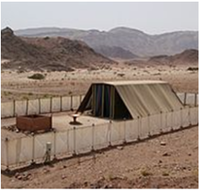
The Beauty and the Priest - Parshat Tetzaveh
It's sometimes hard enough to understand one concept. It can be even harder to understand two concepts simultaneously. It will be even harder if those two concepts are intertwined. That is what's happening to me with last week's parsha and continuing into this week's parsha, Parshat Tetzaveh.
I am as fascinated with God's attention to detail in the building of the Mishkan in last week's parsha as I am with the detail in the preparation of the priestly wardrobe discussed this week in Parshat Tetzaveh. If the Mishkan is a Tabernacle for the people then let the people build it. Weelllll, actually, it is the people's tabernacle for God, and He is the one who asked for it. Okay, so maybe it's okay that He is involved with saying how it should look. And, I'm telling you, He has some expensive taste - gold, silver, leather, diamonds and fancy cloth.1
He wants it to be nice and distinguished and is, therefore, involved in the detail. That is 'Fascinating thing number one'.
Number two – the ark of the covenant, where the tablets were placed is also called the Ark of the Testimony, as the tablets placed therein stand as testimony that we accepted the covenant at Sinai.2 Well, if it were to be testimony, then it should be like the other testimonial, the glass jar holding a piece of Manna. It should be transparent so it can fulfill its purpose of "testimony". And, in addition, even if it needs to hidden in an opaque ark, the ark should at least be made available to the people – not hidden behind screens where only the High Priest enters, and even that occurs only once a year. 'Fascinating thing number two'.
Perhaps, those things which are most precious, most holy, must remain hidden from us.3 Yet even if they are to be hidden, it should be in a beautiful box because we are human and react to beauty.4 So the tablets must remain hidden yet be encased in a gold-covered ark.
We very clearly see our body. We can even usually see how our psyche reacts to our body and how our body reacts to our psyche. In this way we are no different from our furried and feathered cohabitants on this planet. Yet, our highest level of living, the human, noetic, and spiritual level cannot be easily viewed, nor can the meaning towards which it strives be easily identified. The hidden, noetic realm of the human is encased within our physical exterior and we are admonished to care for that exterior.5 The meaning, however, which is the essence of our existence, for which it strives is also usually hidden and needs to be discovered.6 It is not readily seen and can be elusive until we are prepared to actually find it. 'Fascinating thing number three.'
It is beautiful, it is special and it is hidden. We are challenged to find that beauty within.
Click here to read another logoParsha post on Tetzaveh
Notes
- Shemot 25:3-7
- Rashi - Shemot 25:8
- ibid. 26:13 - I noticed this afterwards - "people should care for their fine things."
- If you don’t believe that we react differently to beauty, then just ask Lizzie Velasquez. She will explain a: that we react very strongly to appearances and b: there is great importance in looking past the outside appearances.
See this TEDx talk by Lizzie "How do you Define Yourself?" - Vayikra 18:5 and other places
- This concept of meaning being the main motivation in one's life is mentioned often in the works of Viktor Frankl.
Have A Great Shabbat!![]()
For More Information On Logotherapy And How You Can Create A Fuller, More Meaningful Life, Or To Book An Online Session,
- Call Me At +972-54-589-3399, or in Israel 054-5893399
- Contact Me Thru my email at [email protected]

 Previous
Previous

